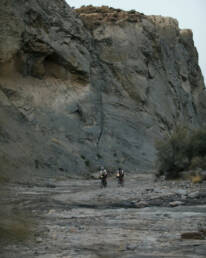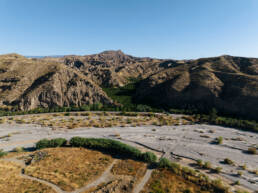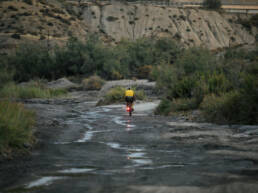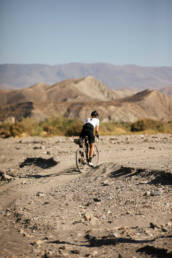INTO THE RAMBLAS
ONE OF THE MOST DISTINCTIVE LANDSCAPES OF THE TABERNAS DESERT ARE THE DRY AND SANDY RIVER BASINS KNOWN AS 'RAMBLAS', FROM THE ARABIC WORD RAMLA: SANDBANK
About 8 million years ago the sea extended until the South face of Sierra de los Filabres. When Sierra de Alhamilla emerged one million years later, it closed a narrow area between them, what would conform the Tabernas Desert.
During the last 100.000 years the ramblas have evolved, deepening and widening their river beds, creating valleys almost 100 metres deep and river courses whose width exceeds a hundred metres, forming the main arteries of the drainage network in the Tabernas Basin.


Although the flow of water in the river bed is just occasional, the temporary and torrential precipitations generates a sudden and powerful erosive process that excavates laterally along the length of the margins supplying a great amount of sediment to theses river beds.
These very intensive floods produce grooves, which grow toward rills and runnels, and terminate in furrows separated by sharp crests. This distinctive and unique landscape is given the name ‘Badlands’, alluding to its difficulty for being worked or put into agricultural production.



The Ramblas have been used since ancient times for communication routes, traditionally livestock trails, due to the wide and soft terrain and the microclimate created by local humidity and the shadows of the canyon walls.
There are also some spots where subterranean water emerges, although usually saline, so plants that thrive in these places – often forming dense patches of vegetation – need to be salt-resistant, like the omnipresent salsola genistoides.
About the fauna, despite this harsh landscape, there is a wealth of vertebrates, most notably birds and reptiles, such as ladder snakes, spiny-footed lizards and ocellated lizards.


The Badlands route uses to include some of the most popular Ramblas of the Tabernas Desert, such as the Rambla de Gérgal, Rambla de Tabernas and Rambla del Búho, close to the village of Tabernas, or the Rambla de los Molinos just before the Sierra de Alhamilla.
These unique places have been widely used as a set for films such as A Fistful of Dollars, The Good, the Bad and the Ugly, Conan the Barbarian or the Dothraki Camps in Game of Thrones.
Although riding in the Ramblas is a mind-blowing experience, the sandbanks and stones demand a great physical and mental effort, constantly keeping an eye on the terrain and holding strongly the handlebar to keep the wheels in the right direction.


